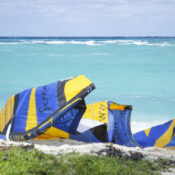People often ask me “What’s the best time of year to visit the Bahamas?” or “What’s your favorite month?” While I can find pros (and sometimes cons) of each month and season throughout the year, I generally have an immediate reply. Before I tell you what that is, let me give you a rundown on some of the various seasons in the Bahamas.
I would broadly categorize the climate of the Bahamas into two seasons – wet season and dry season. Now let me be clear that wet season in the Bahamas isn’t like rainy season in Costa Rica or Thailand’s monsoon season, where I am aware that visiting during that time can lead to endless days of torrential downpours which dampen (literally) your ability to move about and do the fun touristy things you want to do.
Our wet season starts in mid to late May and runs through September or October. It comes about because both the air temperature and the Atlantic Ocean temperature warm up and create clouds, evaporation, and thunder and lightning storms. If you listen to the automated weather report on the VHF radio, you’ll hear the same weather report day after day, week after week… “afternoon showers and thunderstorms possible.” The showers and thunderstorms are generally isolated. It’s rare that a system will move in and affect the entire country with several days of rain, unless there’s an organized tropical depression, tropical storm or a hurricane. You might be on an island and see dark clouds forming and evidence of heavy rains in the distance, but it could blow past and you never even get a drop.
During this time you can expect high humidity, and plenty of mosquitoes! Because of warmer temperatures in the Atlantic, moisture in the air, and low pressure systems, this creates a perfect meteorological soup for hurricanes to form. Late July through the end of September is peak hurricane season, so many part-time residents head north and most visitors don’t gamble with booking their trips during this time in the event of cancelations.
While all of those factors might not sound ideal, for us locals summertime is for boating, swimming, snorkeling, and beaching. Believe it or not, winter feels cold to us, so we’re more likely to hang out at the beach and get in the water after things have heated up a bit. To read more, check out our article Summertime in the Bahamas: What to Expect and Why You Should Visit.
So, that brings us to the winter months, or dry season. Due to our proximity to the mainland United States, we are often affected by northern cold fronts. A blizzard in Boston eventually leads to winter weather for us too, but to a much lesser extent. We aren’t digging our cars out from under a snowbank, but we do don hoodies and long pants fairly regularly. Having a defined winter and summer season is what’s special about living in the northern part of this tropical island belt of the western hemisphere. I do know people further south that wear shorts and tank tops and deal with an endless runoff of sweat all year, which I could see getting monotonous (and uncomfortable).
On the plus side, if you’re visiting from somewhere up north, the winter temperatures in the Bahamas probably still feel warm for you. These temps range from the low 60’s to the high 70’s. The bugs are at a minimum which is a bonus for sitting outside during the sunset hours. And if you’re a kiteboarder, kiteboarding in the Bahamas during the winter is one of the best ways to enjoy the winter weather!
Accommodation-wise you’ll be paying peak season rates during Christmas, New Years, Easter, and spring break. Expect to see lower rates during the late summer and early fall.
So that brings me to answer the question that so many of you have asked me over the years. What’s the best month to visit?
My vote, for whatever it’s worth, is May. We’ve gotten past the cold fronts, but there’s still a nice breeze. It’s warmed up enough to get in the ocean, but it’s not so hot yet that the showers and thunderstorms are a regular fixture, which means there’s no standing water, and no mosquitoes hatching eggs in said standing water. We’ve gotten past Easter and spring break, so the tourist bustle has tapered off, meaning you’ll have more elbow room on the beach and at popular dive spots.

In May, the colors start to pop as the sun moves into the radius of our side of the world. Bougainvillea, in all its glorious shades of tropical chroma overflow in messy brambled vines, spilling over stucco walls lining sunbleached alleys and lanes. The greens of sea lettuce and coconut palms compliment the hundred hues of blues as the ocean expands into the backdrop. There is a softness in the air – the bite of winter has fallen behind, and the intensity of summer has yet to engulf us with its sticky wrath.
But as with any season, it continues its endless turn into the next. And you can be sure that June will offer something that will captivate our hearts as well.






0 Comments